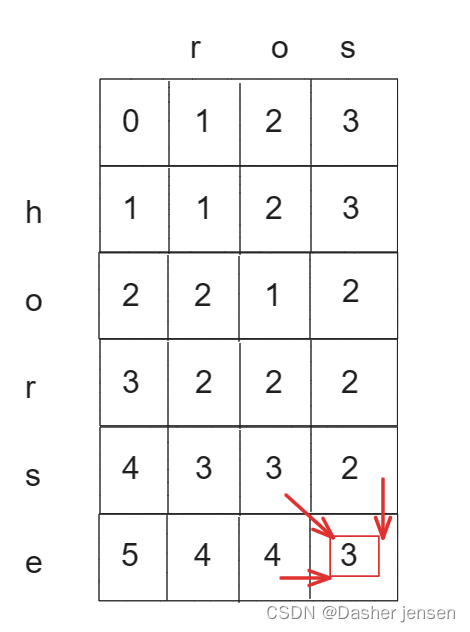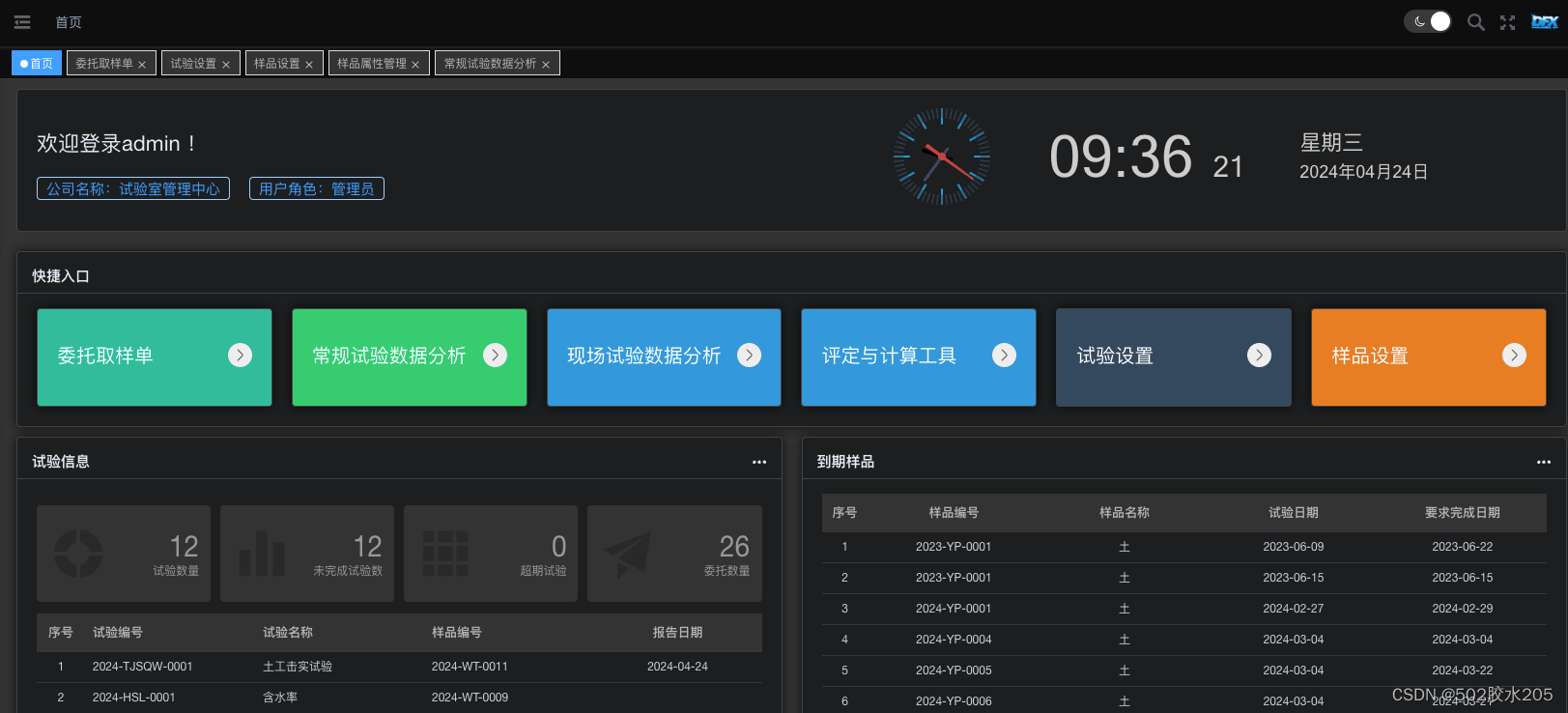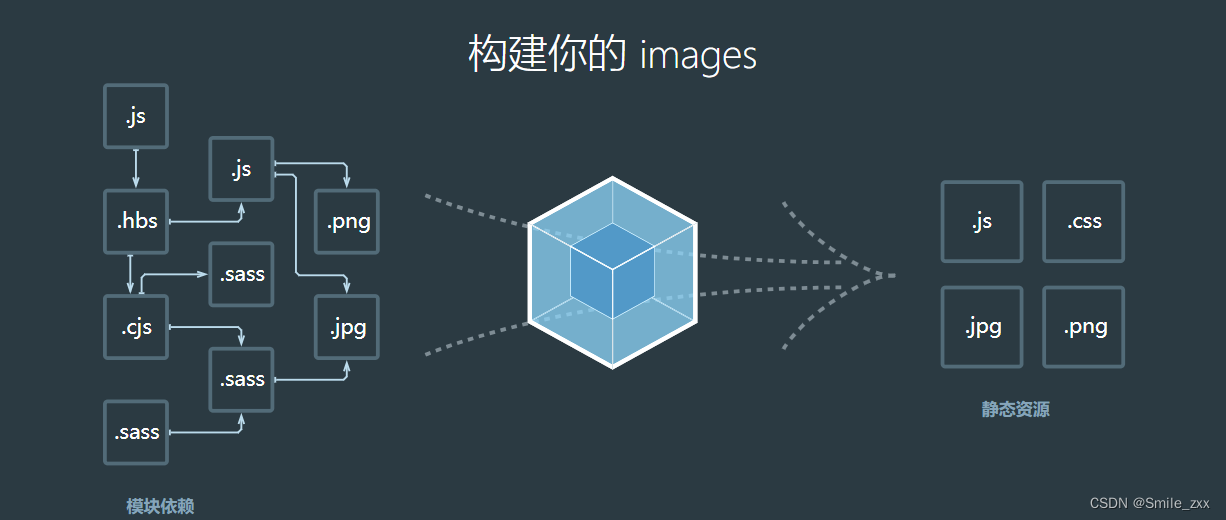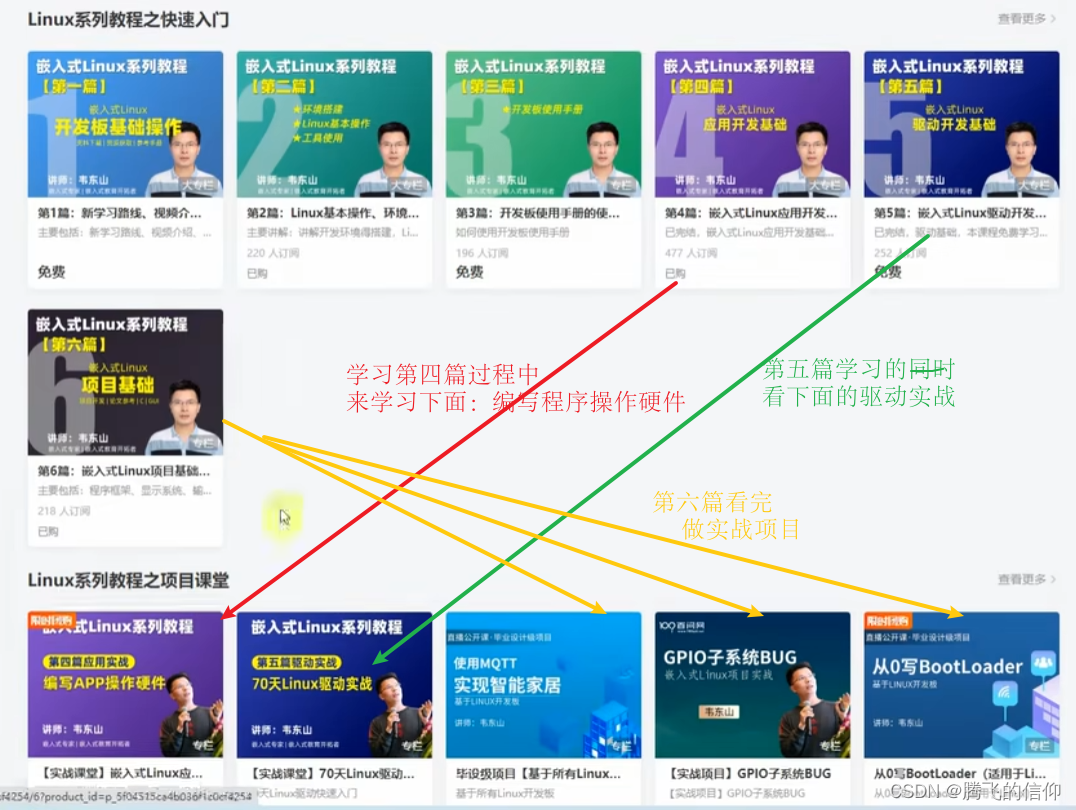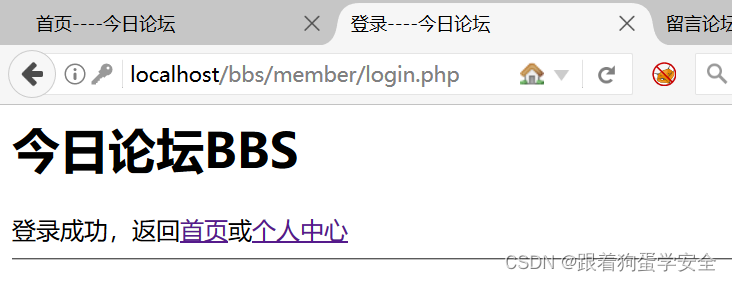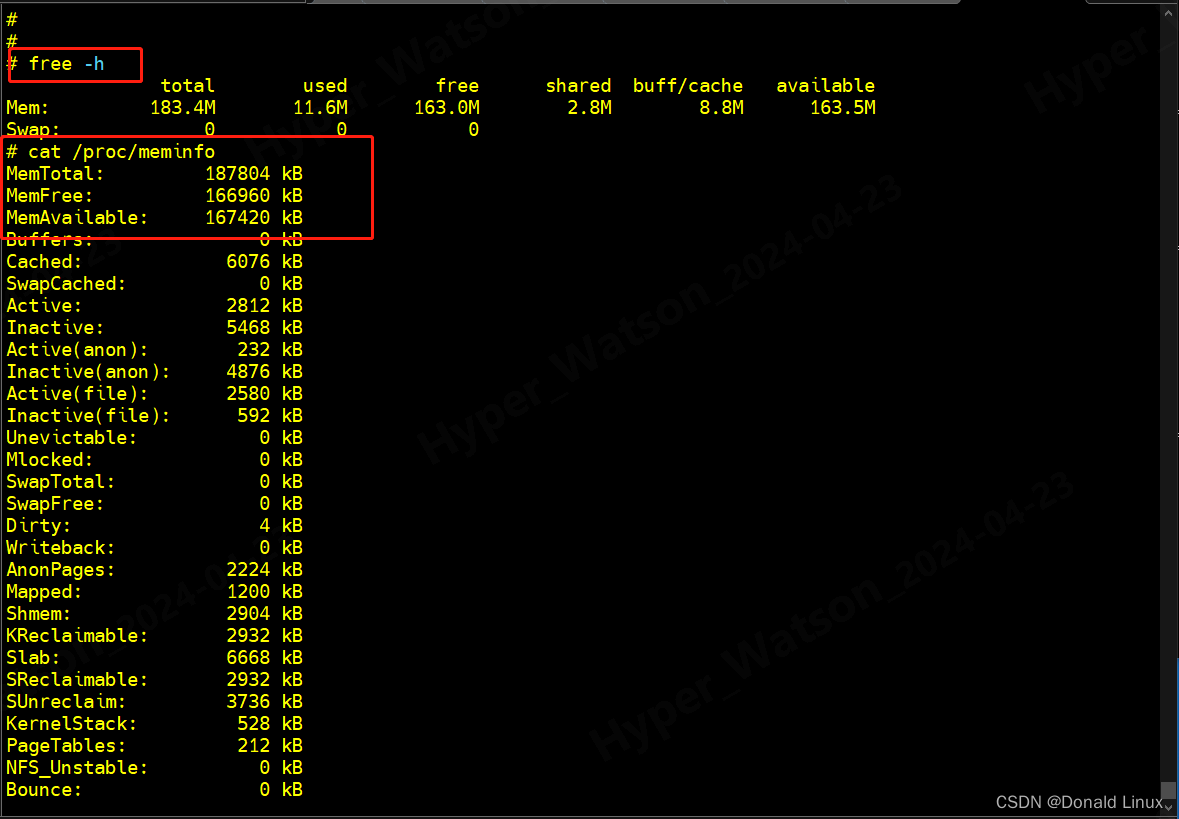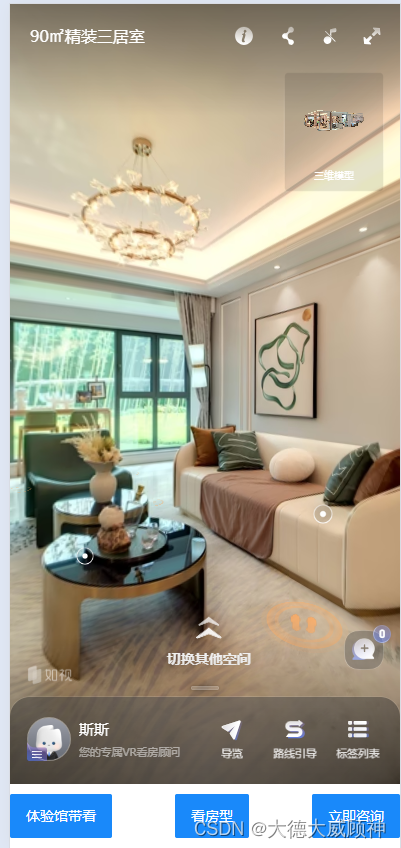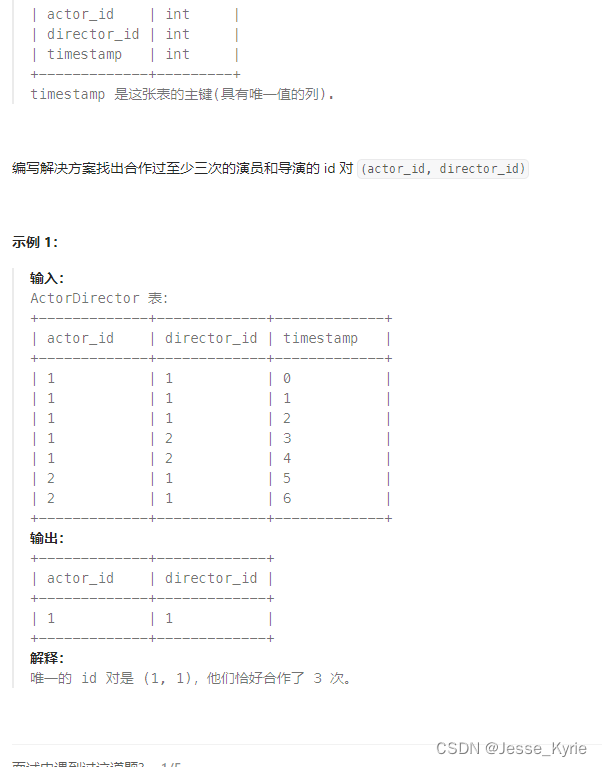1 Handler链调用-需求
使用自定义的编码器和解码器来说明Netty的Handler调用机制。客户端发送long类型数据到服务端;服务端发送long到客户端。
2 Handler链调用-实战
2.1 NettyServer.java
public class NettyServer {
public static void main(String[] args) {
NioEventLoopGroup bossGroup = new NioEventLoopGroup(1);
NioEventLoopGroup workerGroup = new NioEventLoopGroup();
try {
ServerBootstrap serverBootstrap = new ServerBootstrap();
serverBootstrap.group(bossGroup,workerGroup)
.channel(NioServerSocketChannel.class)
.childHandler(new MyServerInitializer());//自定义一个初始化类
ChannelFuture sync = serverBootstrap.bind(8000).sync();
sync.channel().closeFuture().sync();
}catch (Exception e){
e.printStackTrace();
}finally {
bossGroup.shutdownGracefully();
workerGroup.shutdownGracefully();
}
}
}2.2 MyServerInitializer.java
public class MyServerInitializer extends ChannelInitializer<SocketChannel> {
@Override
protected void initChannel(SocketChannel ch) throws Exception {
ChannelPipeline pipeline = ch.pipeline();
//对入站的Hadler进行解码
pipeline.addLast(new MyByteToLongDecoder2());
//对出站的Handler进行解码
pipeline.addLast(new MyLongToByteEncoder());
//自定义Handler
pipeline.addLast(new MyServerHandler());
}
}2.3 MyByteToLongDecoder2.java
public class MyByteToLongDecoder2 extends ReplayingDecoder<Void> {
@Override
protected void decode(ChannelHandlerContext ctx, ByteBuf in, List<Object> out) throws Exception {
System.out.println("MyByteToLongDecoder2 被调用");
out.add(in.readLong());
}
}2.4 MyLongToByteEncoder.java
public class MyLongToByteEncoder extends MessageToByteEncoder<Long> {
@Override
protected void encode(ChannelHandlerContext ctx, Long msg, ByteBuf out) throws Exception {
System.out.println("MyLongToByteEncoder 被调用");
System.out.println("msg = " + msg);
out.writeLong(msg);
}
}
2.5 MyServerHandler.java
public class MyServerHandler extends SimpleChannelInboundHandler<Long> {
@Override
protected void channelRead0(ChannelHandlerContext ctx, Long msg) throws Exception {
System.out.println("从客户端:"+ctx.channel().remoteAddress() + "读取到long类型数据:"+msg);
//向客户端发送一个long类型数据
ctx.writeAndFlush(123456L);
}
@Override
public void exceptionCaught(ChannelHandlerContext ctx, Throwable cause) throws Exception {
cause.printStackTrace();
ctx.close();
}
}2.6 NettyClient.java
public class NettyClient {
public static void main(String[] args) {
NioEventLoopGroup g = new NioEventLoopGroup();
try {
Bootstrap bootstrap = new Bootstrap();
bootstrap.group(g)
.channel(NioSocketChannel.class)
.handler(new MyClientInitializer());
ChannelFuture sync = bootstrap.connect("127.0.0.1", 8000).sync();
sync.channel().closeFuture().sync();
}catch (Exception e){
e.printStackTrace();
}finally {
g.shutdownGracefully();
}
}
}2.7 MyClientInitializer.java
public class MyClientInitializer extends ChannelInitializer<SocketChannel> {
@Override
protected void initChannel(SocketChannel ch) throws Exception {
ChannelPipeline pipeline = ch.pipeline();
//加入一个出站的handler 对数据进行一个编码
pipeline.addLast(new MyLongToByteEncoder());
//这时一个入站的解码器(入站handler )
pipeline.addLast(new MyByteToLongDecoder2());
//加入一个自定义的handler , 处理业务
pipeline.addLast(new MyClientHandler());
}
}2.8 MyClientHandler.java
public class MyClientHandler extends SimpleChannelInboundHandler<SocketChannel> {
@Override
protected void channelRead0(ChannelHandlerContext ctx, SocketChannel msg) throws Exception {
System.out.println("服务器的ip=" + ctx.channel().remoteAddress());
System.out.println("收到服务器消息=" + msg);
}
@Override
public void channelActive(ChannelHandlerContext ctx) throws Exception {
System.out.println("MyClientHandler 发送数据");
//ctx.writeAndFlush(Unpooled.copiedBuffer(""))
ctx.writeAndFlush(654321L); //发送的是一个long
}
}3 运行结果
服务端
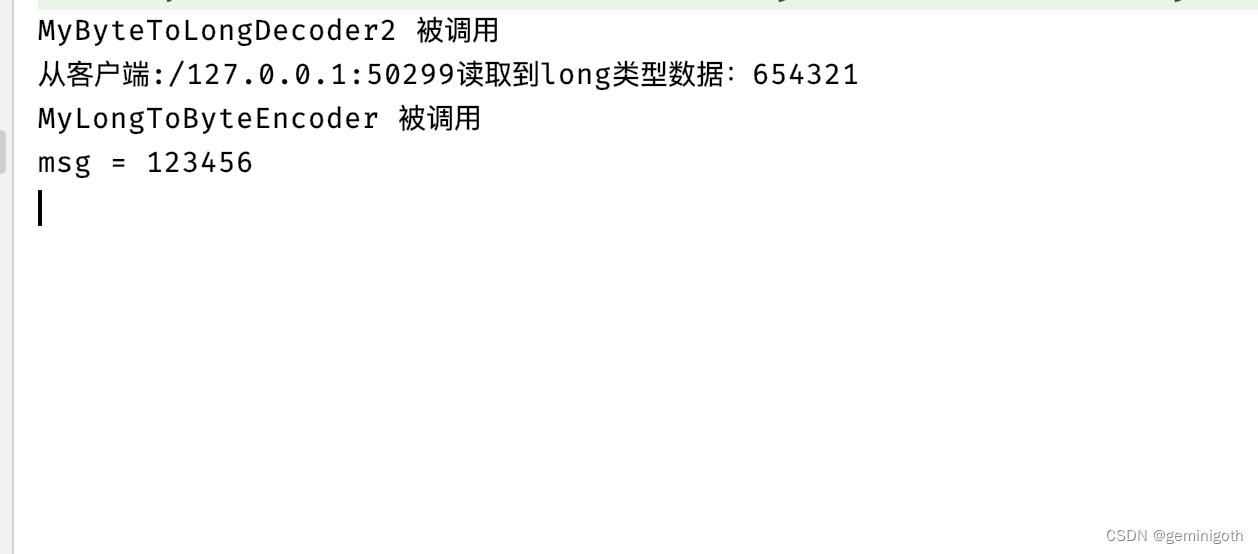
客户端
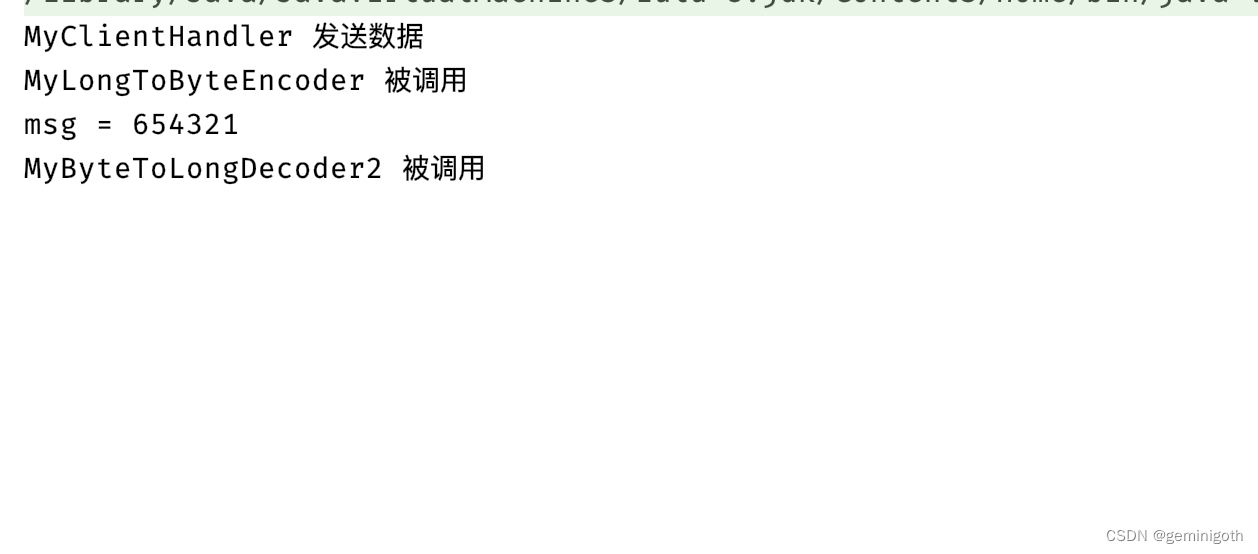
4 复现TCP粘包和拆包
4.1 NettyServer.java
public class NettyServer {
public static void main(String[] args) {
NioEventLoopGroup bossGroup = new NioEventLoopGroup(1);
NioEventLoopGroup workerGroup = new NioEventLoopGroup();
try {
ServerBootstrap serverBootstrap = new ServerBootstrap();
serverBootstrap.group(bossGroup,workerGroup)
.channel(NioServerSocketChannel.class)
.childHandler(new MyServerInitializer ());
ChannelFuture channelFuture = serverBootstrap.bind(8000).sync();
channelFuture.channel().closeFuture().sync();
}catch (Exception e){
e.printStackTrace();
}finally {
bossGroup.shutdownGracefully();
workerGroup.shutdownGracefully();
}
}
}4.2 MyServerInitializer.java
public class MyServerInitializer extends ChannelInitializer<SocketChannel> {
@Override
protected void initChannel(SocketChannel ch) throws Exception {
ChannelPipeline pipeline = ch.pipeline();
pipeline.addLast(new NettyServerHandler());
}
}4.3 NettyServerHandler.java
@Slf4j
public class NettyServerHandler extends SimpleChannelInboundHandler<ByteBuf> {
private int count;
@Override
protected void channelRead0(ChannelHandlerContext ctx, ByteBuf msg) throws Exception {
byte[] bytes = new byte[msg.readableBytes()];
msg.readBytes(bytes);
//将bytes转换成字符串
String result = new String(bytes, Charset.forName("utf-8"));
log.info("服务器接收到的数据:{}",result);
log.info("服务器接收的消息量是:{}",(++this.count));
//服务器返回数据给客户端
ByteBuf byteBuf = Unpooled.copiedBuffer(UUID.randomUUID().toString(),Charset.forName("utf-8"));
ctx.writeAndFlush(byteBuf);
}
@Override
public void exceptionCaught(ChannelHandlerContext ctx, Throwable cause) throws Exception {
cause.printStackTrace();
ctx.close();
}
}4.4 NettyClient.java
public class NettyClient {
public static void main(String[] args) {
NioEventLoopGroup group = new NioEventLoopGroup();
try {
Bootstrap bootstrap = new Bootstrap();
bootstrap.group(group)
.channel(NioSocketChannel.class)
.handler(new MyClientInitializer ());
ChannelFuture channelFuture = bootstrap.connect("127.0.0.1", 8000).sync();
channelFuture.channel().closeFuture().sync();
}catch (Exception e){
e.printStackTrace();
}finally {
group.shutdownGracefully();
}
}
}4.5 MyClientInitializer.java
public class MyClientInitializer extends ChannelInitializer<SocketChannel> {
@Override
protected void initChannel(SocketChannel ch) throws Exception {
ChannelPipeline pipeline = ch.pipeline();
pipeline.addLast(new MyClientHandler ());
}
}4.6 MyClientHandler.java
@Slf4j
public class MyClientHandler extends SimpleChannelInboundHandler<ByteBuf> {
private int count;
@Override
public void channelActive(ChannelHandlerContext ctx) throws Exception {
for (int i = 0; i < 10; i++) {
ByteBuf byteBuf = Unpooled.copiedBuffer("hello,server" + i, Charset.forName("UTF-8"));
ctx.writeAndFlush(byteBuf);
}
}
@Override
protected void channelRead0(ChannelHandlerContext ctx, ByteBuf msg) throws Exception {
byte[] buffer = new byte[msg.readableBytes()];
msg.readBytes(buffer);
String result = new String(buffer, Charset.forName("utf-8"));
log.info("客户端接收的消息是:{}",result);
log.info("客户端接收的消息数量是:{}",(++this.count));
}
@Override
public void exceptionCaught(ChannelHandlerContext ctx, Throwable cause) throws Exception {
cause.printStackTrace();
ctx.close();
}
}多次运行客户端。服务端运行结果如下:

5 TCP 粘包和拆包解决方案
5.1 解决思路
使用自定义协议+编解码器来解决
重点:要解决服务器端每次读取数据长度的问题,这个问题解决后,就不会出现服务器多读或者少读数据的问题,从而避免TCP粘包和拆包。
5.2 需求
1、要求客户端发送5个Message对象,客户端每次发送一个Message对象。
2、服务端每次接收一个Message对象,分5次进行解码。每次读取一个Message,就回复一个Message对象给客户端。
5.3 自定义 消息协议类:MessageProtocol.java
public class MessageProtocol {
private int length;//长度
private byte[] content;//内容
public int getLength() {
return length;
}
public void setLength(int length) {
this.length = length;
}
public byte[] getContent() {
return content;
}
public void setContent(byte[] content) {
this.content = content;
}
}5.4 自定义编码器: MyMessageEncoder.java
@Slf4j
public class MyMessageEncoder extends MessageToByteEncoder<MessageProtocol> {
@Override
protected void encode(ChannelHandlerContext ctx, MessageProtocol msg, ByteBuf out) throws Exception {
log.info("MyMessageEncoder 的 encode 方法被调用");
out.writeInt(msg.getLength());
out.writeBytes(msg.getContent());
}
}
5.5 自定义解码器: MyMessageDecoder.java
/*
自定义解码器,把二进制字节码转换成 MessageProtocol对象
*/
@Slf4j
public class MyMessageDecoder extends ReplayingDecoder<Void> {
@Override
protected void decode(ChannelHandlerContext ctx, ByteBuf in, List<Object> out) throws Exception {
log.info("MyMessageDecoder 的 decode方法被调用");
int length = in.readInt();
byte[] bytes = new byte[length];
in.readBytes(bytes);
//封装成MessageProtocol对象
MessageProtocol messageProtocol = new MessageProtocol();
messageProtocol.setLength(length);
messageProtocol.setContent(bytes);
//把 MessageProtocol对象放入list中
out.add(messageProtocol);
}
}5.6 MyServerHandler.java
@Slf4j
public class MyServerHandler extends SimpleChannelInboundHandler<MessageProtocol> {
//计数器
private int count;
@Override
public void exceptionCaught(ChannelHandlerContext ctx, Throwable cause) throws Exception {
cause.printStackTrace();
ctx.close();
}
@Override
protected void channelRead0(ChannelHandlerContext ctx, MessageProtocol msg) throws Exception {
//接收数据,并处理
int length = msg.getLength();
byte[] content = msg.getContent();
log.info("服务器接收到信息如下,消息长度是:{},消息内容是{}",length,new String(content, Charset.forName("utf-8")));
log.info("服务器接收到数据包的数量是:{}",(++this.count));
//服务器回复消息
String responseMessage = UUID.randomUUID().toString();
int responseLength = responseMessage.getBytes("utf-8").length;
byte[] responseMessageBytes = responseMessage.getBytes("utf-8");
//构建协议包
MessageProtocol messageProtocol = new MessageProtocol();
messageProtocol.setLength(responseLength);
messageProtocol.setContent(responseMessageBytes);
ctx.writeAndFlush(messageProtocol);
}
}5.7 MyServerInitializer.java
public class MyServerInitializer extends ChannelInitializer<SocketChannel> {
@Override
protected void initChannel(SocketChannel ch) throws Exception {
ChannelPipeline pipeline = ch.pipeline();
pipeline.addLast(new MyMessageDecoder());
pipeline.addLast(new MyMessageEncoder());
pipeline.addLast(new MyServerHandler());
}
}5.8 MyServer.java
public class MyServer {
public static void main(String[] args) {
NioEventLoopGroup bossGroup = new NioEventLoopGroup(1);
NioEventLoopGroup workerGroup = new NioEventLoopGroup();
try {
ServerBootstrap serverBootstrap = new ServerBootstrap();
serverBootstrap.group(bossGroup,workerGroup)
.channel(NioServerSocketChannel.class)
.childHandler(new MyServerInitializer());
ChannelFuture channelFuture = serverBootstrap.bind(8000).sync();
channelFuture.channel().closeFuture().sync();
}catch (Exception e){
e.printStackTrace();
}finally {
bossGroup.shutdownGracefully();
workerGroup.shutdownGracefully();
}
}
}5.9 MyClientHandler.java
@Slf4j
public class MyClientHandler extends SimpleChannelInboundHandler<MessageProtocol> {
private int count;
@Override
public void channelActive(ChannelHandlerContext ctx) throws Exception {
//使用客户端发送10条数据
for (int i = 0; i < 5; i++) {
String msg = "孔乙己" + i;
int length = msg.getBytes().length;
byte[] bytes = msg.getBytes();
MessageProtocol messageProtocol = new MessageProtocol();
messageProtocol.setContent(bytes);
messageProtocol.setLength(length);
ctx.writeAndFlush(messageProtocol);
}
}
@Override
protected void channelRead0(ChannelHandlerContext ctx, MessageProtocol msg) throws Exception {
int length = msg.getLength();
byte[] content = msg.getContent();
log.info("客户端接收到消息如下,长度:{},内容:{}",length,new String(content, Charset.forName("utf-8")));
log.info("客户端接收消息数量是:{}",(++this.count));
}
@Override
public void exceptionCaught(ChannelHandlerContext ctx, Throwable cause) throws Exception {
ctx.close();
}
}5.10 MyClientInitializer.java
public class MyClientInitializer extends ChannelInitializer<SocketChannel> {
@Override
protected void initChannel(SocketChannel ch) throws Exception {
ChannelPipeline pipeline = ch.pipeline();
pipeline.addLast(new MyMessageEncoder());
pipeline.addLast(new MyMessageDecoder());
pipeline.addLast(new MyClientHandler());
}
}5.11 MyClient.java
public class MyClient {
public static void main(String[] args) {
NioEventLoopGroup group = new NioEventLoopGroup();
try {
Bootstrap bootstrap = new Bootstrap();
bootstrap.group(group)
.channel(NioSocketChannel.class)
.handler(new MyClientInitializer());
ChannelFuture channelFuture = bootstrap.connect("127.0.0.1", 8000).sync();
channelFuture.channel().closeFuture().sync();
}catch (Exception e){
e.printStackTrace();
}finally {
group.shutdownGracefully();
}
}
}
5.12 运行结果
服务端:
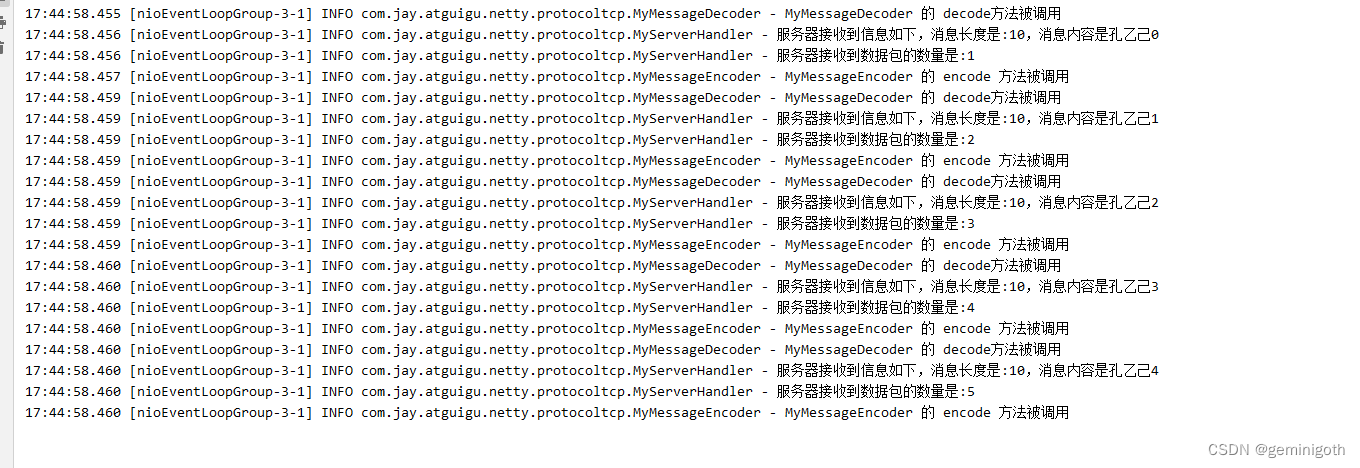
客户端:


